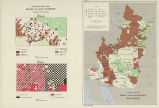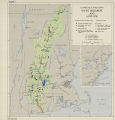| OCR Text |
bonds from the companies to accomplish these purposes. Consideration also should be given to control of debris which was placed in stream channels by earlier uncontrolled mining operations, and is now moving slowly downstream as part of rivers' bed load. 7. Mining Claims on Public Lands The Problem Action required to prevent the validation of fraudulent mining claims on public lands. The Situation Fraudulent mining claims often are made on public lands. The real purpose of these claims is to acquire recreation sites at cascades, waterfalls, and the like and minor reservoir sites for watering livestock, and to obtain control and eventual land ownership. Legislation also has been sought allow- ing unrestricted location of claims in water power withdrawals. The location of mining claims for nonmining purposes, even though such claims later may prove to be invalid, has been erroneously blamed on the mining industry. Because so much of the land in the basin contains some mineral value, it has been possible to push some mining claims through to patent even though the claimant had no interest in the mineral values and later did not use the land for mineral production. Of 390 entries patented on national forest land in the basin over a 10-year period, only 120 actually produced minerals, and 71 were worked part-time, with little apparent mining interest. The remain- ing 199 entries can only be classified as fraudulent. They were used as follows: 14 2-subdivided for summer homes. 29-timber cut, no further use. 25-commercial (resorts, stores, gas stations, etc.). 26-summer residences. 9-agricultural. 72-no use, some timber cut, property for sale. 36-miscellaneous (none associated with mining). The area covered by the above entries varied from 20 to 1,968 acres; the total for all uses was 59,000 acres. In addition there were 265,000 acres of "live" but unpatented mineral claims in the national forests of the basin, amounting to 3.4 percent of the total national forest area. Of the claims patented in other years than the 390 discussed above, the following disposition is recorded:14 "Source: U. S. Forest Service. The gold claims produced an average of about $53 worth per claim. In one year (1939), the gold production per acre was $5.48. Conclusions Inasmuch as provision is made in other laws for acquiring or leasing public lands for a number of purposes, there is no reason for misuse of the mining laws to obtain land for other purposes. Mining laws require revision in order to prevent such abuse and to promote sound resources use in the basin and in other parts of the Nation. Revisions in the laws also are necessary to protect and encourage sound and legitimate mineral development, using modern techniques in such manner as to be consistent with the best use of all natural resources. 8. Extent to Which Flood Plain Zoning Is Prac- ticable The Problem The practicability of flood plain zoning in the valley to prevent flood damage. The Situation 15 Flood plain zoning is a measure for preventing flood damage through control of land use in areas 15 For a more extended discussion of flood plain zoning problems and possibilities see Flood Plain Zoning, Cali- fornia State Planning Board, 1942, 43 pp. 127 Total JJ£™3 Type of development number W^fter of entries patent Gold claims: Lode...................... 158 89 Placer..................... 216 79 Copper....................... 7 4 Industrial minerals............. 46 13 Feldspar...................... 4 0 Borax......................... 4 0 Building stone................. 5 0 Limestone..................... 10 3 Clay.......................... 10 0 |


























































































































































































































































































































































































































































































































































































































































































































































































































































